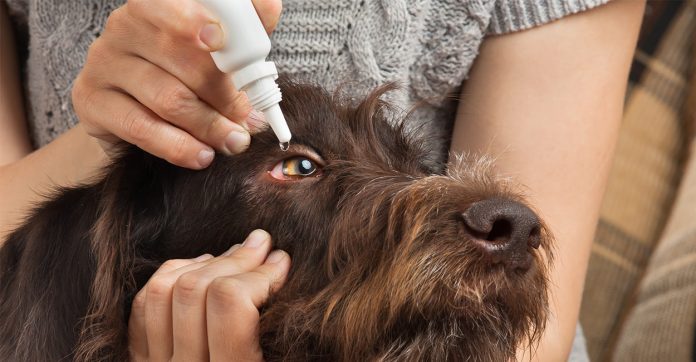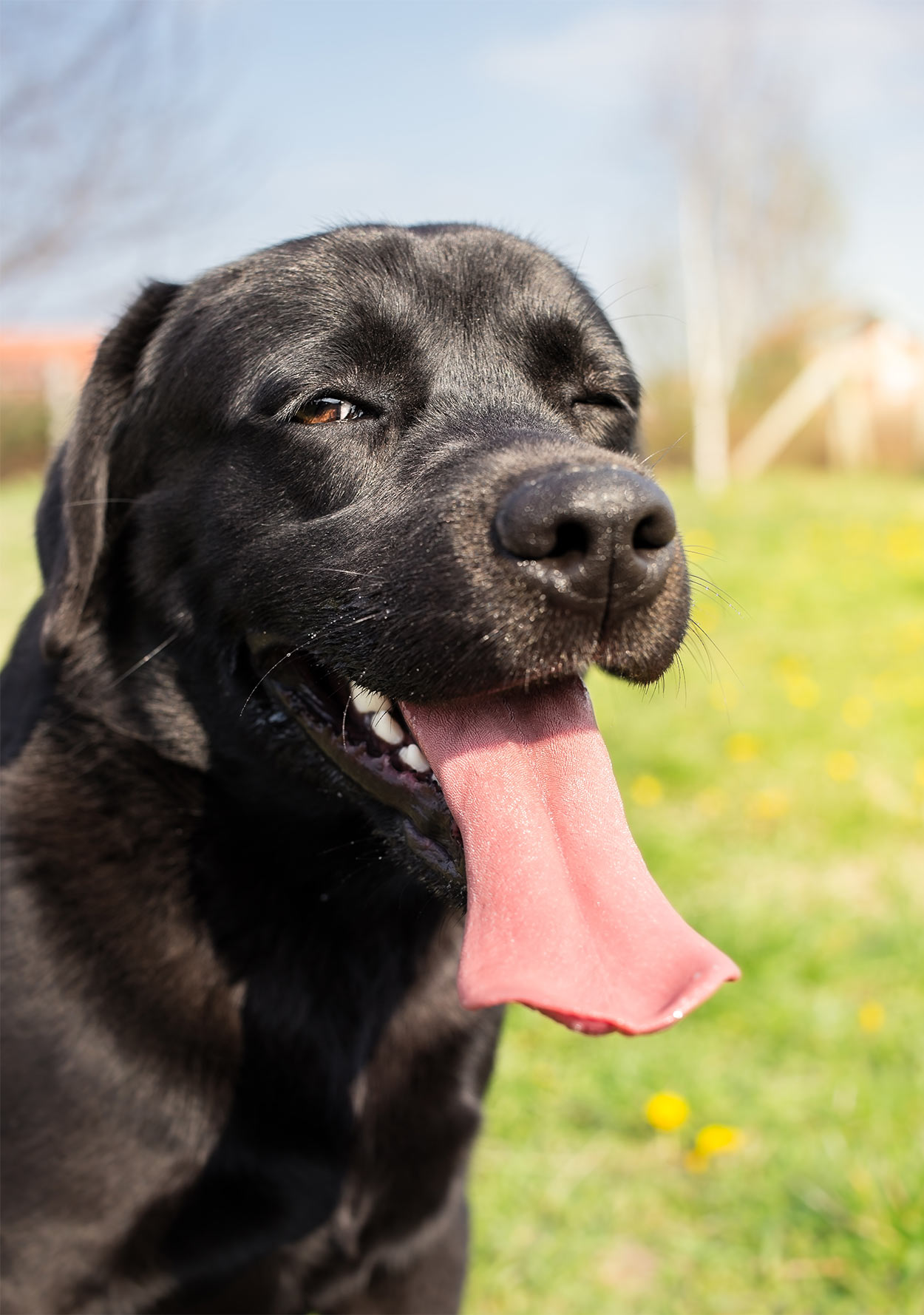Conjunctivitis In Dogs – Symptoms, Treatment And Home Remedies
Conjunctivitis in dogs is a medical condition where the conjunctiva mucous membrane that covers the wihite of the eye and eyelid becomes inflamed. In dogs this includes the third eyelid, known as the nictitating membrane. Inflammation is the body’s response to the threat – the tissue becomes red, swollen and hot. Your dog’s eyes will be wet, sticky and have a thick mucus discharge visible. Conjunctivitis in dogs causes your pet to rub at their eyes with their paws, blink, squint and even leaves them unable to open their eye.
The conjunctiva helps with eye movement and also has a very important protective function. It not only forms a protective barrier, but also contributes to tear production and produces a substance which helps to fight against infections. Although inflammation almost always accompanies and infection, inflammation doesn’t necessarily mean that there is an infection.
Contents
- Signs of conjunctivitis in dogs.
- Infectious vs non infectious conjunctivitis in dogs?
- Home and prescribed treatment options.
- How to prevent conjunctivitis in dogs.
Conjunctivitis in dogs, or pink eye, is quite common. In fact, one study of 31,484 dogs in the US found that 3% had conjunctivitis. That might not sound like many, but if you crunch some numbers, that is almost 950 dogs!
Signs of conjunctivitis in dogs
The most common signs of conjunctivitis – and the reason why we call it pink eye – are redness and swelling of the white of one or both eyes. You may even notice that your pup’s eyelids are swollen. Conjunctivitis in dogs is not usually as obvious as in humans because most of the white part of their eyes is covered by their eyelids. Sometimes the first thing we spot is when the swelling causes the third eyelid to show in the corner of the eye.
Conjunctivitis can be accompanied by an eye discharge – clear, mucus or pussy. A discharge is most likely when there’s an infection. When it’s a viral infection, the condition is likely to be present in both eyes with a clear discharge. A pussy discharge usually points to a bacterial infection. This could be in one eye only when an eye injury becomes infected.
Other signs on conjunctivitis in dogs includes squinting, blinking a lot, and pawing or scratching at their eyes. You dog might also not be able to open one or both eyes. When your pup doesn’t want to allow you near his eyes this is usually a sign of pain. While the above symptoms may indicate that your pooch has conjunctivitis, your vet will need to work out what the actual cause is.
What causes conjunctivitis in dogs?
Fortunately, just like in humans, the most common cause of conjunctivitis, or pink eye, in dogs is an allergic reaction. The irritant could be pollen, dust or chemical compounds like those in cigarette smoke, cleaning materials, or even dog shampoo. If the conjunctivitis is present in one eye only it could be an infection that hasn’t yet spread to the other eye.
However, the most likely potential causes are usually a foreign body such as a grass seed or grit, or injury to the eye. This could be from a blow, a bite, or a puncture injury by something like a thorn. A blocked or infected tear duct, irritation from hair around the eye, or even an abnormal growth could also be behind conjunctivitis in one eye. The condition could be an inflammatory reaction only. But oftentimes it’s a bacterial infection that takes hold after the conjunctiva is injured or irritated.
Infections as the cause of conjunctivitis in dogs
Dogs can get conjunctivitis from specific viral, bacterial or parasitic infections limited to the eyes. However, the condition could also be a symptom of a generalised infection – most often a virus. Just think how your eyes become and inflamed when you have a cold or flu. There are a number of viruses that could be to blame, commonly the canine herpesvirus is the culprit. Or even canine distemper.
Another possible cause is parasitic infections. One example of this is leishmaniasis which can be lethal if it attacks the internal organs and is left untreated. If the parasite attacks the mucosa (such as the conjunctiva) it can leave permanent scars. Leishmaniosis is present in tropical and subtropical regions and can be passed on to humans.
Non-infectious causes of conjunctivitis in dogs
Besides injuries, non-infectious causes of conjunctivitis includes eyelid defects, where the lashes scratch the surface of the eye, tumors. Blocked tear ducts are another cause of inflammation of the conjunctiva, as is dry-eye where not enough tears are produced.
Disorders or other parts of the eye are often accompanied by conjunctivitis. Examples are tumours, and glaucoma – a very serious condition which can cause blindness within 24 hours. So the causes of conjunctivitis in dogs can range from simply some dust in their eyes through to serious conditions that can permanently affect their vision or even be fatal.
Generally, brachycephalic dogs – those with flat faces and prominent eyes – are at higher risk of developing eye problems. According to one study released in 2017 brachycephalic dogs have a 10.8% chance of developing conjunctivitis, compared to a 7.76% chance of the condition developing in non-brachycephalic dogs.
By now you will realise that red, swollen – and possibly goopy – eyes in dogs is often a symptom of some underlying injury or illness. A full examination by your vet is the only way to find out the real cause of your pup’s conjunctivitis.
 My dog’s eyes are red – Should I go to the vet?
My dog’s eyes are red – Should I go to the vet?
When we get red, puffy eyes we usually get a good idea of whether we need to pay a visit to the doctor from how our eyes, and the rest of our body, feel. The problem is that your dog can’t explain to you what he feels. And that makes it very difficult for us to judge how serious the problem is. That’s why it’s best to take your pup to the vet for a proper examination. Furthermore, your dog’s pawing at their eyes can scratch and damage them even more.
If you suspect, or there are obvious signs of, an injury you should pay an emergency visit to your vet. Also if your dog seems to be in pain – a lot of rubbing, squinting and resisting. Eye injuries are often very difficult to see without specialised equipment. The vet will ask some questions about the time leading up to the condition to help establish what the cause could be.
Dog conjunctivitis treatment
Your dog’s treatment will depend on the cause of the conjunctivitis. If the problem is a foreign body or some other type of irritant, then this will need to be removed. When an irritant is present in your dog’s living environment, you’ll need to make a plan to ensure your dog isn’t exposed to this allergen.
If your veterinarian has determined that a bacteria, virus or parasite is to blame, they’ll provide the appropriate antibiotic or antiviral agent. Pain medication, and an antibiotic to prevent infection, might be prescribed if your dog’s eye was injured.
Treatments are usually administered either orally, in the form of tablets or powders, or topically, as eye ointments or eye drops. You should ask your vet for guidance if you’re unsure how to give the treatment to your pet. Surgery may be required in rare cases. This could be, for example, to remove a foreign body, ulcer, or tumor from the eye. Also if the underlying cause of the problem is related to the eyelids or lashes or a blocked tear duct.

Applying Eyedrops
Once your veterinarian has diagnosed the condition, it’s important to follow their treatment directions carefully. You must administer the treatment regularly, as prescribed on the label. In the case of dry-eye you might even have to insert drops at least twice a day for months.
You’ll need to clean your dog’s eyes before you insert eye drops or ointment if there is a lot of discharge. You can do this by wiping them carefully with warm water and a cotton wool ball. When inserting the medicine, find a place with good lighting. Hold you pup, tilt their head up and steady it against your hand or your lap. Then pull down the lower lid and insert the medicine in the space between the eye and the lower lid.
Another tip is to steady your hand against your pup’s head while inserting the medicine. If your dog’s head moves your hand will move with it. This will prevent you from accidentally sticking the point of the applicator into their eye.
A good idea for bigger dogs is to back them up against a wall or furniture so that they can’t suddenly scoot backwards.
Home remedies for conjunctivitis in dogs
The only home remedy that’s recommended for mild eye problems in dogs is a saltwater rinse. You can also use this treatment to clean and keep your dog’s eyes moist while waiting to take him to the vet. Dissolve half a teaspoon of salt in a cup of boiled or mineral water. Use this mixture with cotton wool balls to gently clean your pet’s eyes once or twice a day.
A soothing alternative, believed to be mildly antibacterial, is chamomile tea. Gently rinse your dog’s eyes with the tea or lightly apply the wet, steeped tea bag around their eye. You may have read that diluted apple cider vinegar works for conjunctivitis in dogs. This is not recommended. There is no science to back up the claim that this treatment works and besides, it can be very irritating to your dog’s eyes if there’s an open wound.
Is conjunctivitis contagious to dogs, or even humans?
Generally, it’s unlikely that you will catch conjunctivitis from your dog – although it cannot be completely discounted. Because infections result in your dog’s eye weeping, catching the underlying infection from this fluid is possible.
The parasitic infections that can cause conjunctivitis, for example leishmaniasis and toxocariasis, can also be spread to humans. So common hygienic measures, including washing your hands after treating your pet’s eyes and keeping your dog’s bedding and living areas clean, is a good idea.
Measures for preventing conjunctivitis in dogs
Firstly, ensure that your pup gets all the routine vaccinations. This will protect them from the serious viral infections that are spread through contact with other dogs. For the same reason it’s a good idea to contain your dog in your yard, and to neuter your pooch.
Keep the fur around their eyes trimmed if your dog has long hair . Regular grooming will help prevent eye irritation caused by hair, and prevent foreign bodies that get stuck in their coat from ending up in their eyes. If your dog suffers from conjunctivitis frequently – for example as a result of allergies or dry eye, make sure that you give the treatment regularly as prescribed. Also inspect your dog’s eyes from time-to-time to pick up on problems as soon as they arise.

Free Labrador Updates!
Get my training tips, news, reviews, and the latest from The Labrador Site delivered to your inbox

 My dog’s eyes are red – Should I go to the vet?
My dog’s eyes are red – Should I go to the vet?

How long should you use home remedies for if the pus has stopped?